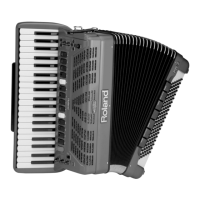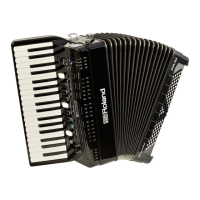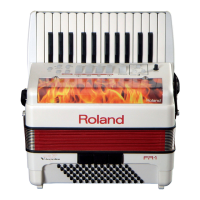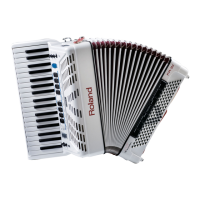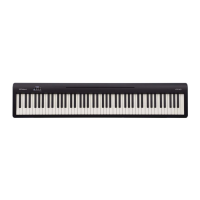Selecting Parameters
89
NOTE
The organ eects described below apply to all sections that use
VTW Organ sound.
Vibrato/Chorus
The vibrato eect cyclically modulates the pitch of organ sounds
(which is dierent from the Rotary eect).
Parameter Value Explanation
Vib/Cho Switch O, On
You can apply vibrato or chorus to the
organ sound.
Vib/Cho Type
V-1, V-2, V-3
C-1, C-2, C-3
The eect will intensify as the vibrato
type (V-1, V-2, V-3) or chorus type (C-1,
C-2, C-3) moves to a higher number
Vib/Cho Vintage ‘50, ‘60, ‘70
Tonewheel used in tonewheel organs of
1950, 1960, 1970.
Vib/Cho Level 0~127
Use this parameter to set the Vibrato or
chorus level.
Overdrive
This eect distorts the sound, giving it an “edge” and making it
suitable for hard rock and similar musical genres. See also the
“NOTE” under “Vibrato/Chorus”.
Parameter Value Explanation
Overdrive Switch O, On
Allows you to switch the overdrive eect
on or o.
Overdrive Drive 0~127
Species how strongly the sound is
distorted. A value toward 127 raise the
gain, adding distortion to the sound.
Overdrive Level 0~127
Species the level of the eect with
respect to the unprocessed organ signal.
Rotary
The eect in this section simulates the typical sound modulation
generated by a cabinet with rotating loudspeakers.
Most functions (start/stop, rotation speed selection, etc.), need to
be selected with an optional MIDI foot controller (e.g. FC-300) ( p.
107), Chin Switches ( p. 98) or Function Switches ( p. 106).
Parameter Value Explanation
Leakage Level 0~127
Species the level of the eect with
respect to the unprocessed organ signal.
Rotary Snd Level 0~127 You can adjust the level of rotary eect.
Rotary Snd
Reverb
0~127
Allows yo to specify the level of the
rotary signal that is transmitted to the
reverb eect.
Choose “0” if the sound should not be
processed by the organ reverb processor.
Rotary Snd
Chorus
0~127
Allows yo to specify the level of the
rotary signal that is transmitted to the
organ chorus eect.
Choose “0” if the sound should not
be processed by the organ chorus
processor.
Rotary Snd Delay 0~127
Allows yo to specify the level of the
rotary signal that is transmitted to the
organ delay eect. Choose “0” if the
sound should not be processed by the
organ delay processor.
9.4 MFX Edit (Not for VTW Organ Tone)
The parameters in this page depend on the MFX
type that you selected.
Select and set the desiderate parameter.
For details regarding MFX edit parameters refer to
the“Tone & Drum Kit List “ supplementary manual.
Download it from the Web http:/ www.roland.com/manuals/.
9.5 MFX Controls (Not for VTW Organ Tone)
Select this page to assign a control to the MFX.
Parameter Value Explanation
Control 1 Source O, EFX Pot, Aftert
Select “EFX Pot” to control
the MFX by “EFFECT”
potentiometer.
Select “After” to control the
MFX by aftertouch.
NOTE
The treble keyboard
of the piano-type
model also generates
aftertouch messages
(on the button- type
model, aftertouch can
be generated with the
Master bar). “Aftertouch”
refers to the fact that
you press a key even
further down after
playing a note.
Control 1 Sens -63~0~+63 Adjust the sensitivity.
Control 1 Assign
The eects to assign depend on the MFX type that
you selected. See “2.3 Eects Send” (p. 72).
Control 2 Source As “Control 1 Source”
Control 2 Sens As “Control 1 Sens”
Control 2 Assign As “Control 1 Assign”
Control 3 Source As “Control 1 Source”
Control 3 Sens As “Control 1 Sens”
Control 3 Assign As “Control 1 Assign”
Control 4 Source As “Control 1 Source”
Control 4 Sens As “Control 1 Sens”
Control 4 Assign As “Control 1 Assign”
9.6 Sound Edit (Not for VTW Organ Tone)
The following parameters allow you to set the
sound’s “envelope” and lters.
The envelope parameters aect both the volume
(TVA) and the lter (TVF). The cuto frequency
will rise as the envelope rises and will fall as the
envelope falls.
Parameter Value Explanation
ATTACK –64~0~+63
See “5.5 Sound Edit” (p. 80) for detailed
information.
DECAY –64~0~+63
See “5.5 Sound Edit” (p. 80) for detailed
information.
RELEASE –64~0~+63
See “5.5 Sound Edit” (p. 80) for detailed
information.
CUTOFF –64~0~+63
See “5.5 Sound Edit” (p. 80) for detailed
information.
DELAY –64~0~+63
This parameter adjusts the time required for
the vibrato eect to begin. Positive (+) settings
increase the time before vibrato will begin and
negative settings shorten the time
DEPTH –64~0~+63
See “5.5 Sound Edit” (p. 80) for detailed
information.
RATE –64~0~+63
See “5.5 Sound Edit” (p. 80) for detailed
information.

